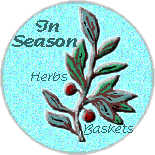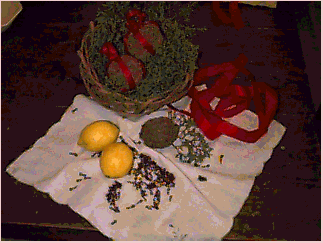
Winter | Spring | Summer | Fall | Holiday
Baskets | Community
Herbs and Baskets
holiday
 Pomanders have been used since the Middle Ages.
The pomanders that we make today are rooted in Colonial and Victorian times.
During those times, pomanders were not only decorative but also useful
to cover up bad odors. They will serve that same useful purpose today,
keeping a closet or little used room fragrant with spices and citrus.
Apples were frequently used as the pomander base during the Colonial period
because oranges were too expensive. Pomanders today are usually made
from oranges. You could choose to make your pomanders from:
Pomanders have been used since the Middle Ages.
The pomanders that we make today are rooted in Colonial and Victorian times.
During those times, pomanders were not only decorative but also useful
to cover up bad odors. They will serve that same useful purpose today,
keeping a closet or little used room fragrant with spices and citrus.
Apples were frequently used as the pomander base during the Colonial period
because oranges were too expensive. Pomanders today are usually made
from oranges. You could choose to make your pomanders from:
- apples
- oranges
- lemons
- limes
- crab apples
- kumquats
Supplies needed:
- fruit for base whole cloves
- powdered/ground spices such as
- cloves
- cinnamon
- ginger
- nutmeg
- powdered/ground orris root
- Mix the spices and orris root together.
This mixture will help your pomander dry and increase its fragrance. It also helps preserve the pomander. Use about one part orris root to four parts spice mixture. - Select firm, ripe fruit with no blemishes.
- Use a skewer of some sort to poke holes in the fruit.
- Push the stem of the clove into the fruit.
- Place the cloves close together on the fruit.
- This is a slow, but pleasant process.
- Try to complete each fruit in one session.
- When the orange or apple is completely covered with cloves, roll it in the spice and orris root mixture.
- Leave it in the spices.
- Put the fruit and spices in a cool, dark place.
- Each day, until the fruit dries, roll it in the spices.
When the pomanders are dry, tie a bright ribbon around them and heap in bowl. You can also run a ribbon through the pomanders and use the ribbon to hang them on the Christmas tree.
- If you want a stronger citrus fragrance, combine the traditional pomander described above with more contemporary designs.
- A quick, pretty pomander can be made by placing cloves in a decorative pattern around an orange. This version does not cover the fruit with cloves and will not last.
- The traditional pomander can be stored for years.
prev next
|
Site design, and webmastery by Cicada Consulting Group
Copyright © In Season Herbs and Basketsc 1997 All rights reserved. |
Page refreshed: Sat, Feb 23, 2002
http://www.inseason.com/holiday/pomander.html |